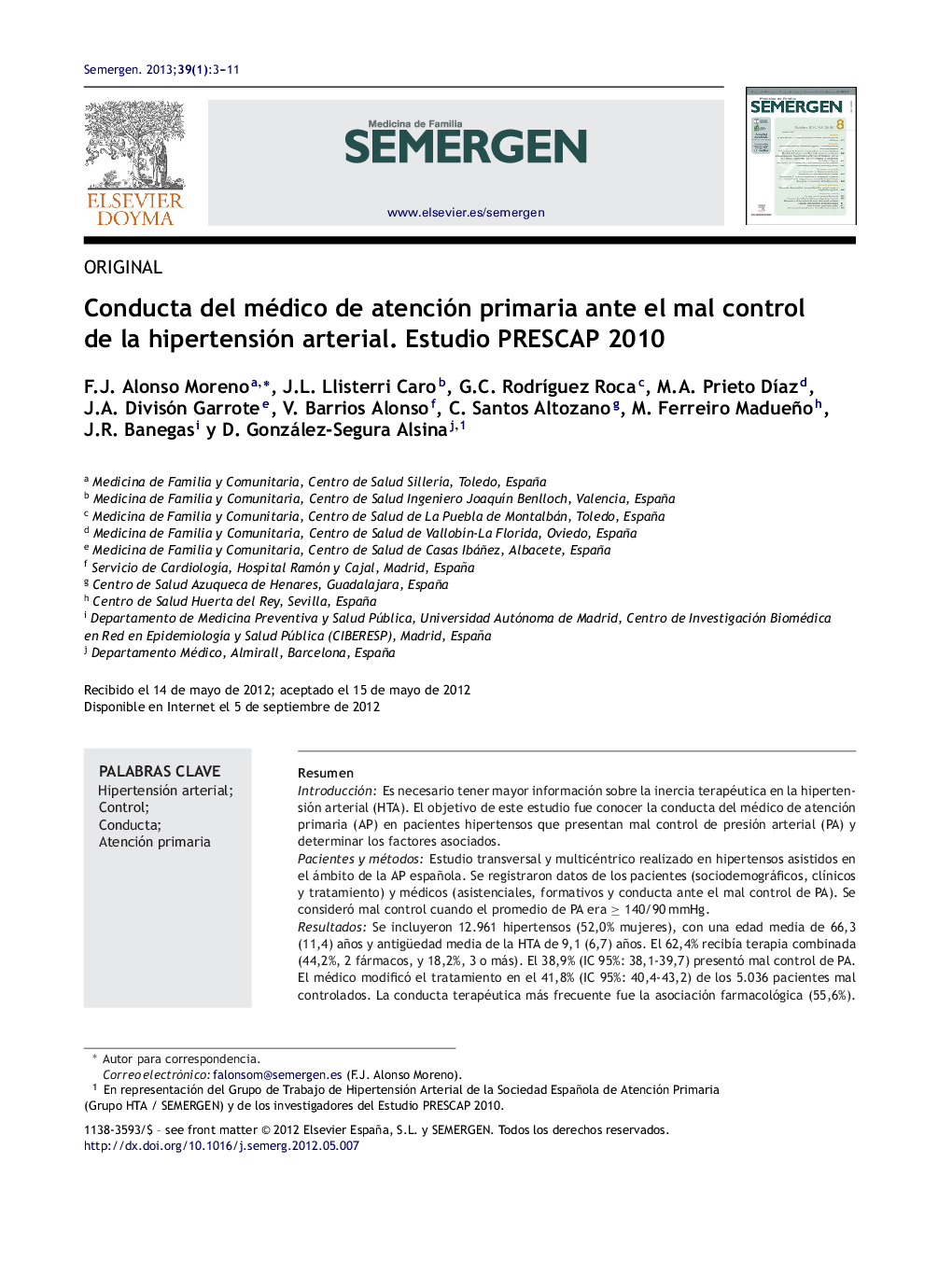| Article ID | Journal | Published Year | Pages | File Type |
|---|---|---|---|---|
| 3835193 | SEMERGEN - Medicina de Familia | 2013 | 9 Pages |
ResumenIntroducciónEs necesario tener mayor información sobre la inercia terapéutica en la hipertensión arterial (HTA). El objetivo de este estudio fue conocer la conducta del médico de atención primaria (AP) en pacientes hipertensos que presentan mal control de presión arterial (PA) y determinar los factores asociados.Pacientes y métodosEstudio transversal y multicéntrico realizado en hipertensos asistidos en el ámbito de la AP española. Se registraron datos de los pacientes (sociodemográficos, clínicos y tratamiento) y médicos (asistenciales, formativos y conducta ante el mal control de PA). Se consideró mal control cuando el promedio de PA era ≥ 140/90 mmHg.ResultadosSe incluyeron 12.961 hipertensos (52,0% mujeres), con una edad media de 66,3 (11,4) años y antigüedad media de la HTA de 9,1 (6,7) años. El 62,4% recibía terapia combinada (44,2%, 2 fármacos, y 18,2%, 3 o más). El 38,9% (IC 95%: 38,1-39,7) presentó mal control de PA. El médico modificó el tratamiento en el 41,8% (IC 95%: 40,4-43,2) de los 5.036 pacientes mal controlados. La conducta terapéutica más frecuente fue la asociación farmacológica (55,6%). La percepción por parte del médico de buen control de PA en el hipertenso mal controlado y la presencia de terapia combinada fueron las variables que mostraron mayor probabilidad de no modificar el tratamiento farmacológico.ConclusionesEl médico de AP modifica el tratamiento antihipertensivo en tan solo 4 de cada 10 hipertensos mal controlados. La percepción por parte del médico de buen control de PA es la variable que más incrementa la probabilidad de no modificar el tratamiento farmacológico.
IntroductionThere is a need for more information on therapeutic inertia in blood pressure (BP) treatment. The purpose of this study was to determine the therapeutic behaviour and associated factors of Primary Care (PC) physicians on uncontrolled hypertensive patients.Patients and methodsCross-sectional multicentre study of patients with hypertension attending Spanish PC centres. Data was collected from patients (social-demographics, clinical status and treatment), as well as data from physicians (medical practice, background and therapeutic behaviour) were collected. Uncontrolled BP was considered when average BP values where ≥140/90 mmHg.ResultsA total of 12,961 patients (52.0% women) were included. The mean age was 66.3 (SD 11.4) years, and mean number of years from diagnosis of hypertension was 9.1 (6.7) years. Almost two-thirds (62.4%) of the patients were taking a combined blood pressure treatment, (44.2% with two drugs and 18.2% with three drugs, or more). An uncontrolled BP was observed in 38.9% (95% CI: 38.1-39.7) of patients. Treatment was changed by physicians in 41.8% (95% CI: 40.4-43.2) out of 5,036 uncontrolled patients. Adding another drug was the most frequent behaviour (55.6%). The physician's perception of good BP control in uncontrolled patients, together with the presence of combined blood pressure treatment, were the two variables most strongly associated with therapeutic inertia.ConclusionsThe Spanish PC Physician modified antihypertensive treatment in only 4 out of 10 uncontrolled patients. The physician's perception of good BP control was the variable most strongly associated with therapeutic inertia.
